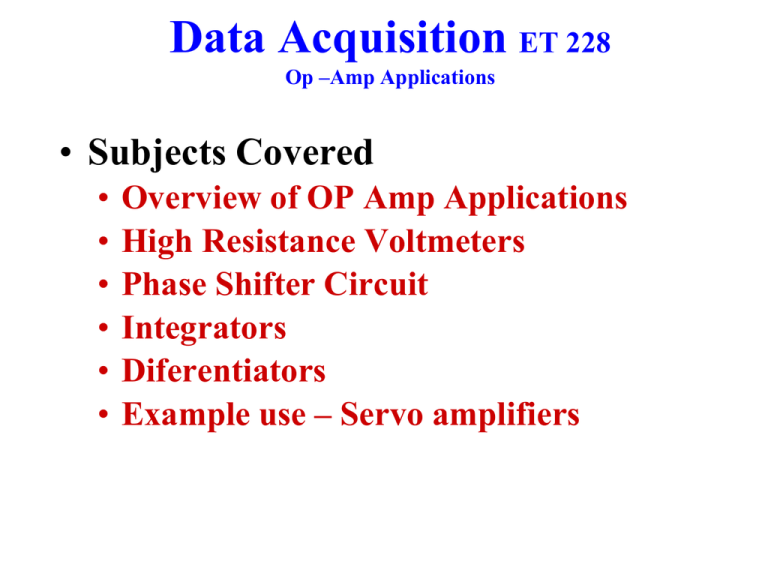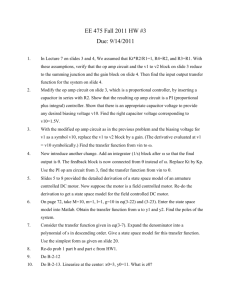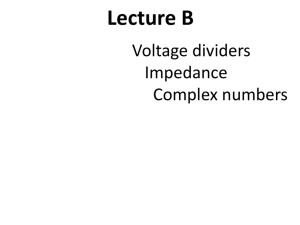Servo amplifiers Data Acquisition ET 228 Op –Amp Applications
advertisement

Data Acquisition ET 228
Op –Amp Applications
• Subjects Covered
•
•
•
•
•
•
Overview of OP Amp Applications
High Resistance Voltmeters
Phase Shifter Circuit
Integrators
Diferentiators
Example use – Servo amplifiers
Data Acquisition ET 228
Op –Amp Applications
• Overview of Op-Amp Applications
• Chapter five covers a varied set of OP-Amp
applications
• Measuring short circuit current
• Measure output from photo detectors
• Equalize audio tones of different amplitudes
• Control high currents
• Allow matching of semiconductor characteristics
• High resistance DC/AC voltmeter
• A phase shift circuit
• Integrators and differentiators
• Servo Amplifiers
Data Acquisition ET 228
Op –Amp Applications
• High Resistance DC Voltmeter
• See Figure 5.1 on page 119
• Voltage to be measured is input to the + pin
• Ed = 0
• Thus I = Ei /Ri
• Limits per design
• Input voltage range: -1.0 to 1 V
• Do Example problem 5-1 on page 120
• Two simple steps to change the voltmeter into one
with an input range of -10.0V to 10V
• _____________
• _____________
• Do Example problem 5-2 on page 120
Data Acquisition ET 228
Op –Amp Applications
• Universal High Resistance Voltmeter
• See Figure 5.2 on page 121
• Measures DC, rms, Peek, and Peak-Peak voltages
• Sector switch for the Ranges
• Bridge circuit around meter – current only flows
through it in one direction
• Limits per design – Full Scale reading per
selected Scale
•
•
•
•
Max DC Input voltage: 5 VDC
Max rms Input voltage: 5 Vrms
Max Peak Input voltage: 5 VPeak
Max Peak-Peak Input voltage: 5 VPeak-Peak
Data Acquisition ET
228
Op –Amp Applications
• Universal High Resistance Voltmeter
• Design considerations
• Meter has full scale rating of 50 micro-amps it only reads
average voltage
• On the DC setting it has a 100K ohm resistor to Common
• 50 micro-amps X 100k ohms = 5VDC
• On the rms scale it has a 90 k ohm resistor and an average
voltage on the input of 4.5V will yield a full scale deflection
Vrms 0.707 xVPeak 5Vrms 0.707 x7.07VPeak
7.07VPeak from bridge rectifier 0.636 xVPeak 0.636 x7.07VPeak 4.50VPeak
Data Acquisition ET
228
Op –Amp Applications
• Universal High Resistance Voltmeter
• Design considerations
• On the Peak setting it has a 63.6K ohm resistor to Common
VPeak
1
1
xV Ave 5VPeak
x3.18V Ave
0.636
0.636
• 50 microamps times 63.6k ohms = 3.18VAve
• On the Peak-Peak setting it has a 31.8K ohm resistor to
Common
VPeak Peak
1
1
xV Ave 5VPeak Peak
x1.59V Ave
0.318
0.318
Data Acquisition ET
228
Op –Amp Applications
• Phase Shifter Circuit
• See figure 5-13 on page 137
•
•
•
•
Low pass passive filter on Op-Amp + input
Voltage on Op-Amp – input = Voltage on + input (VCap)
Voltage across other Input resistor = Ei – VCap = I
Voltage out has a phase shift equal to twice the phase shift
on the input Cap
• Output amplitude =Input amplitude
• Design procedure
• Phase angle shift only depends upon Ri, Ci, and frequency
of the input signal
𝜽
𝜽 = 𝟐 𝒂𝒓𝒄𝒕𝒂𝒏 𝟐𝝅𝒇𝑹𝒊 𝑪𝒊
OR
𝑹𝒊 =
𝒕𝒂𝒏(𝟐)
𝟐𝝅𝒇𝑪𝒊
Data Acquisition ET
228
Op –Amp Applications
• Phase Shifter Circuit
• Design procedure
• Steps
• Determine the desired phase shift and frequency of input
signal
• Set Ci to an appropriate value for the input frequency
• Determine the value of Ri using one of the equations above
• Example problems 5-13 and 5-14
• Proof of concepts
• 𝑽𝑪𝒂𝒑 =
−𝒋𝑿𝑪
𝒙
𝑹𝒊 −𝒋𝑿𝒄
𝑬𝒊
𝑬𝒊 = 𝑨 𝒔𝒊𝒏𝟐𝝅𝒇𝒕
• Voltage on pin 2 = 𝑽𝑪𝒂𝒑
• Voltage across other input resistor =𝑬𝒊 - 𝑽𝑪𝒂𝒑
Data Acquisition ET
228
Op –Amp Applications
• Phase Shifter Circuit
• Proof of concepts
Note; phase shift across the resistor from the input = the phase
shift from the LP filter. There will be the same phase shift
across the feedback resistor THUS double the phase shift on
the Cap
𝑬𝒊 = 𝑨𝒔𝒊𝒏𝟐𝝅𝒇𝒕 = 𝑨@𝟎𝒐
𝑰𝒇 =
𝑬𝒊 −𝑽𝑪
𝑹𝒇
𝑽𝑪 =
−𝒋𝑿𝑪
𝑬
𝑹𝒊 −𝒋𝑿𝑪 𝒊
𝑽𝑪 = 𝑬𝒊 − 𝑰𝒇 𝑹
• With f=1kHz and Ri = 15.9 k ohms and A=1V
𝑬𝒊 = 𝑨𝒔𝒊𝒏 𝟔. 𝟐𝟖𝒌𝒕 = 𝟏@𝟎𝒐
−𝑗15.9𝑘
𝑽𝑪 =
𝟏@𝟎𝒐 = 𝟎. 𝟕𝟎𝟕@ − 𝟒𝟓𝒐
15.9𝑘 − 𝑗15.9𝑘
Data Acquisition ET
228
Op –Amp Applications
• Phase Shifter Circuit
• Proof of concepts
With f=1kHz and Ri = 15.9 k ohms and A=1V
𝑰𝒇 =
𝑬𝒊 −𝑽𝑪
𝑹𝒇
=
𝟏−(𝟎.𝟓−𝒋𝟎.𝟓)
𝟏𝟎𝟎𝒌 𝒐𝒉𝒎𝒔
=
𝟎.𝟓+𝒋𝟎.𝟓
𝟏𝟎𝟎𝒌 𝒐𝒉𝒎𝒔
= 𝟕. 𝟎𝟕𝝁𝑨@𝟒𝟓𝟎
𝑽𝑹−𝟏𝟎𝟎𝒌 = 𝑽𝑹𝒇 = 𝑰𝒇 𝒙𝟏𝟎𝟎𝒌 𝒐𝒉𝒎𝒔 = 𝟎. 𝟕𝟎𝟕@𝟒𝟓𝒐
𝑽𝑶 = 𝑽𝑪 − 𝑽𝑹𝒇 = 𝟎. 𝟕𝟎𝟕@ − 𝟒𝟓𝒐 − 𝟎. 𝟕𝟎𝟕@𝟒𝟓𝒐
𝑽𝑶 = 𝟎. 𝟓 − 𝒋𝟎. 𝟓 − 𝟎. 𝟓 + 𝒋𝟎. 𝟓 = −𝒋𝟏. 𝟎 = 𝟏@ − 𝟗𝟎𝒐
Data Acquisition ET 228
Op –Amp Applications
• Integrators
• Reference Circuit:
• Fig 5-15 on page 141
• Inverting Op-Amp circuit with the feedback resistor
replaced with a capacitor
• The case of the input voltage being a step function is
shown
• VO is shown as a ramp voltage
• Analysis
• Iin or input current with respect to time {i(t)}
• The voltage difference between the two Op-Amp input
terminals is assumed to be 0V DC (Ed = 0V)
Data Acquisition ET 228
Op –Amp Applications
• Integrator Circuits
• Analysis
• Iin or input current
with respect to time {i(t)}
ein
i (t )
Ri
1
v idt
C
• Voltage across a capacitor is
and when i(t) replaces I in the voltage
c
equation and realize the output of an
inverting amplifier is a negative voltage we have
1
vO
Ri C f
eindt
YIELDS
eint
vo
Ri C f
For t greater than the start time of the input voltage step
Note: If Ei is a sine wave the output will be a negative cosine wave.
t
0
Data Acquisition ET 228
Op –Amp Applications
• Integrator Circuits
• Analysis
•
•
•
•
•
eint
vo
Ri C f
When t = 0, VO = 0V (initial equilibrium voltage)
When t = 1/10 of RiCf, VO = - 0.1 x ein V
When t = 1/2 of RiCf, VO = - 0.5 x ein V
When t = 0.9 of RiCf, VO = - 0.9 x ein V
When t = RiCf, VO = - ein V
• Conclusion
• For input step functions to an integrator the output is a ramp
style output voltage
• Goes from the output before the input and ramps to the
saturation voltage with the opposite polarity
Data Acquisition ET 228
Op –Amp Applications
• Integrator Circuits
• Conclusion
eint
vo
Ri C f
• For other input functions over a range of time find the
indefinite integral answer
• Solve using the value of time for the end of the range
• Solve using the value of time for the start of the range
• Subtract the second answer from the first
Notes:
ES = 0V, IS = 0A
Iin = ein /Rin, If = Iin
Data Acquisition ET 228
Op –Amp Applications
• Servoamplifier
• Uses an Integrator to delay the full effect of an input
voltage change to the output voltage
• See Figure 5-16 on page 143
• The first Op-amp is the integrator
• The second Op-amp is an inverter with a gain of “-1”
• The positive feedback voltage (VF)causes the integrator’s output
to stop at “-2” times the input voltage
» VF is set at ½ the output voltage
» How would you set VF at a different fraction of the output, thus
changing the steady-state gain?
» VC must climb to 3 times Vin and the circuits time constant is 3
times that of a simple series RC circuit. Thus τ = 3RiC
• Work Example problem 5-15 Starting on bottom of page 143
Data Acquisition ET 228
Op –Amp Applications
• Servoamplifier
• How long of a delay
• Stability in 5 τ
• In addition noise during the transition is zeroed out
• The time delay is caused by the time required for the Cap to
charge to a new value required by the change in the input
voltage
• The voltage on the cap in figure 15-6 changes per the
following:
t starts at 0 when Ei changes and
It stops when ΔVC = 3 ΔEi
Ei t
VC
Ri C
Data Acquisition ET 228
Op –Amp Applications
• Servoamplifier
• Why does VC need to be 3 time Ein -- Why does τ equal
3 time RiC
• Iin shrinks to zero as VF approaches Ein and becomes zero
when they are equal
• When the voltages are stable, VF = ½ VO and the output
voltage of the integrator = - VO
= -2 VF = -2 Vin
• By inspection then VC must = 3 times (note polarity shown in
figure 5-16)
• Also, τ is 3 times RiC since the Cap must charge to 3 times the
input voltage to reach stability
• Other cases
• If VF = VO , then VC would equal 2Ei and τ would = 2RiC
• If VF = 1/4VO , then what would VC equal??
Data Acquisition ET 228
Op –Amp Applications
• Differentiators
• Looks like an Integrator with the Cap and resistor
swapped
• Operation
• Performs the mathematical operation of differentiation
• VO equals the negative of the derivative of Ei (see text book on
page 145 in figure 5-17 for the equation)
dei
VO R f Ci
dt
OR
VO
Ei R f Cin
t
Data Acquisition ET 228
Op –Amp Applications
• Differentiators
• Operation
Notes:
Ed = 0V, Id = 0A
Iin = {Δ Ein CinRf}/Δt, If =
Iin
Data Acquisition ET 228
Op –Amp Applications
• Differentiators
• Problems
• Unstable – may oscillate
• However it is a plus factor when making a multivibrator by
adding positive feedback
• Gain increases with frequency
• XC decreases with increased frequency, thus the gain will
increase with increased frequency
• Solution
• Add a parallel Cap to the Feedback Resister and a series
resistor to the input Cap
• Design procedure
• See bottom of page 145
Data Acquisition ET 228
Op –Amp Applications
• Differentiators
• Design procedure
• Work example problem 5-18
• Device recommendations
• Op Amps with high slew rates






